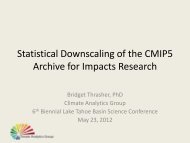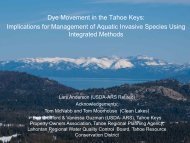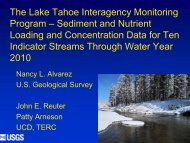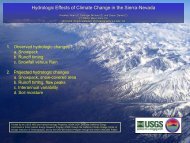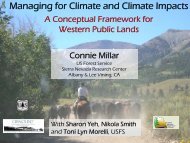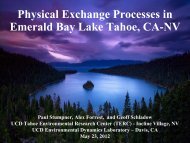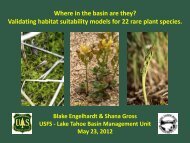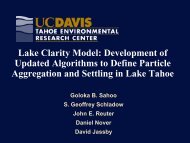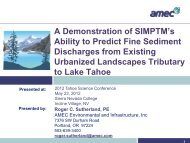Steissberg, Todd E
Steissberg, Todd E
Steissberg, Todd E
Create successful ePaper yourself
Turn your PDF publications into a flip-book with our unique Google optimized e-Paper software.
Nearshore Temperature Estimations Over<br />
Time and Space with Thermal Infrared<br />
Satellite Images<br />
<strong>Todd</strong> <strong>Steissberg</strong>, Ph.D. 1<br />
Marcy Kamerath 2<br />
Sudeep Chandra, Ph.D. 2<br />
1<br />
Tahoe Environmental Research Center<br />
University of California, Davis<br />
2<br />
Department of Natural Resources and<br />
Environmental Sciences<br />
University of Nevada, Reno<br />
Tahoe Science Conference, 2012<br />
May 23, 2012
• Problem<br />
Introduction<br />
• Temperature is a major limiting factor in lakes<br />
• Influences growth, reproduction, distribution<br />
• Invasive species<br />
• Nearshore temperature information is limited<br />
• Solution<br />
• Satellite measurements can provide temperature estimations over<br />
time and space<br />
• Provide past, present, future time series<br />
• Provide cost and time-effective sampling of entire littoral zone
• Another Problem<br />
Introduction<br />
• High resolution satellite sensors can “see” the nearshore but are<br />
limited over time<br />
• 60 – 90 m pixels<br />
• 1 – 2 images/month<br />
• Moderate resolution sensors acquire sub-daily images, but the<br />
nearshore radiance is contaminated by land<br />
• Solution<br />
• 1000 m pixels overlap water and land<br />
• 2 – 4 images per day<br />
• Use sub-daily MODIS images to measure temperature indirectly<br />
• Sample offshore and predict predict/estimate nearshore
Satellite Measurements<br />
• MODIS – Moderate Resolution Imaging Spectroradiometer<br />
• Two MODIS sensors in orbit (Terra and Aqua satellites)<br />
• 1000 m spatial resolution (Thermal Infrared, TIR)<br />
• 0.5 day repeat time (each sensor, in TIR)<br />
• 2 TIR images per day per sensor, 4 total<br />
• 36 spectral bands<br />
• 6 TIR bands: 20, 27, 29, 31, 32, 35<br />
• Bands 31 and 32 ideal for temperature estimation<br />
• High quality, low noise<br />
• Atmospheric window<br />
• Several bands can be used for QA/QC and atmospheric<br />
correction<br />
• Calibrate radiance data to water skin temperature (WST)<br />
• WST is analogous to SST, but for lakes<br />
• Skin temperature: temperature of top 0.01 – 1 mm layer of<br />
water
Offshore Skin Temperature Calibration/Validation<br />
WS, WDir<br />
Air Temp., RH<br />
Net Rad.<br />
Skin Temp.<br />
Bulk Water<br />
Temp.
MODIS, ASTER, ETM+ Comparison<br />
June 3, 2001<br />
18:28 UTC<br />
T m = 11.9 o C<br />
June 3, 2001<br />
19:06 UTC<br />
T m = 12.3 o C<br />
MODIS,<br />
Actual Size<br />
June 3, 2001<br />
19:06 UTC<br />
T m = 12.0 o C<br />
June 3, 2001<br />
06:10 UTC<br />
T m = 11.4 o C
MODIS Monthly WST, 2006
Satellite Temperature Data before Cloud Masking<br />
Sampled at Mid-Lake
Cloud Detection and Masking<br />
• MODIS standard cloud masking (spectral screening, threshold tests):<br />
• Band 27<br />
• Band 31<br />
• Band 35<br />
• Band 20 – Band 32<br />
• Band 31 – Band 29<br />
• Band 31 – Band 32<br />
• Problem<br />
• Seasonal variation<br />
• Solution<br />
• Detrend spectral test data<br />
• k 1 *sin(p*abs(day + k 2 )/365.25) 4 + k 3<br />
• Detrend daytime and nighttime data separately
Screened Satellite Temperature Data<br />
Band 31, Day<br />
Band 31, Night<br />
Band 20 – Band 32, Day<br />
Band 20 – Band 32, Night
Screened Satellite Temperature Data
Nearshore Calibration<br />
• 20 nearshore in situ sampling<br />
sites, using iButton thermistors<br />
• 50 MODIS “sampling” sites<br />
• 50 corresponding nearshore<br />
MODIS prediction/estimation sites<br />
• Weekly averages are computed to<br />
remove diurnal variation<br />
differences<br />
• Weekly offshore WST regressed<br />
against weekly sub-surface<br />
nearshore in situ temperatures<br />
• Derived equations applied to<br />
multiple adjacent sites<br />
• Inset: regression and prediction<br />
• T Nearshore = k 1 *T Offshore + k 2
Regression:<br />
MODIS Offshore vs. In Situ Nearshore<br />
Sunnyside<br />
Taylor Creek Outflow
Coefficients of Determination
MODIS-Derived Nearshore Water Temperature<br />
Marla Bay
Nearshore Variability by Week
Conclusions<br />
• Nearshore temperatures can be predicted along the entire shoreline,<br />
providing a basis for comparing thermal regimes.<br />
• For non-native species, whose distribution or spawning activity is<br />
closely tied with temperature, this information can direct or prioritize<br />
management and monitoring to the most thermally suitable areas,<br />
earliest in the growing season.<br />
• Satellite-derived and in situ temperature results for Lake Tahoe indicate<br />
that the locations most susceptible to invasion by warm-water fishes are<br />
Emerald Bay, near Taylor creek, along the southern shoreline, and<br />
Crystal Bay (northeast).<br />
• Snorkeling surveys in 2006 and 2007 indicated presence of two<br />
non-native warm-water fish species (Lepomis macrochirus and<br />
Micropterus salmoides) in these locations<br />
• The first detections of warm-water fish species in a season<br />
occurred in these locations
Acknowledgements<br />
• Dr. Simon Hook, Dr. Ali Abtahi, NASA/JPL<br />
• Dr. Geoffrey Schladow, Brant Allen, UC Davis<br />
• Funding Sources:<br />
• Southern Nevada Public Lands Management Act<br />
(SNPLMA)<br />
• Nevada Division of State Lands<br />
• University of Nevada, Reno
Questions?




